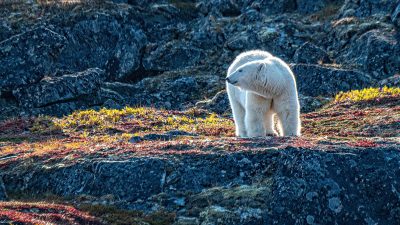Article | Destinations
Here’s Why the Aurora Borealis Will Leave Your Heart Glowing
By Aaron Spitzer | January 04, 2021
Related expedition: Greenland & Wild Labrador: A Torngat Mountains Adventure and The Northwest Passage

©Dennis Minty
Article | Destinations
By Aaron Spitzer | January 04, 2021
Related expedition: Greenland & Wild Labrador: A Torngat Mountains Adventure and The Northwest Passage

©Dennis Minty
The Northern Lights, or aurora borealis, occur when supercharged solar particles interact with our planet’s magnetic field as much as 400 kilometres above the Earth. Eerie green or pink ribbons of light emerge, hovering, undulating, and sometimes even ricocheting across the night sky. Though auroral displays may very rarely appear at temperate latitudes, they’re most vivid and frequent in the polar regions.
Unsurprisingly, the Northern Lights have for eons been the stuff of Arctic lore. According to stories shared by Inuit cultural educators who travel with Adventure Canada, the lights are said to represent the spirits of departed loved ones, joyfully playing ball with a walrus skull. Other tellings reverse it: the players are walruses, and the skull is human. Still other teachings say that if you whistle, the lights will come closer—but beware! If they come too close, they may snatch you into the sky.

© Lee Narraway
In recent decades, Northern Lights viewing has become a multi-million-dollar tourism industry. Each winter, tens of thousands of “aurora hunters,” especially from China and Japan, flock to places like Iceland, Norway, Alaska, and the Northwest Territories in Canada, scanning the frosty sky in hopes of being graced by a light show. The biggest challenge they encounter is escaping big-city lights—which, for Adventure Canada, is our specialty.
Indeed, aurora borealis viewing is it a potential highlight on our September or October journeys, when the midnight sun of summer is coming to a close. Of course, the aurora’s unpredictability is part of its appeal. Sometimes we’ll be lucky and get a show on the very first evening, interrupting our scheduled entertainment and sending everyone flocking outside. Other times, the lights will remain elusive, or will only flare up in the wee hours of the night.

© Scott Forsyth
To get the most of the lights, head for a dark place on the ship, especially the top deck. There, you’ll have a view of the full sweep of the sky, with minimal interference from electric lights. Dress extra warm and bring a mug of coffee or cocoa, to help prolong your enjoyment of the spectacle. Better yet, bring a camera with a tripod and a slow shutter speed to capture the phenomena for posterity. (Indeed, it’s often easier to see the lights’ vibrant colours in photos than with the naked eye.) It’s an experience that’s sure to light up your life!

September 17 to October 1, 2025
From $9,495 to $19,095 USD
per person based on double occupancy
Save 15%

September 27 to October 11, 2026
From $15,995 to $24,195 USD
per person based on double occupancy

August 28 to September 11, 2026
From $11,995 to $22,795 USD
per person based on double occupancy

August 16 to September 1, 2025
From $14,495 to $28,995 USD
per person based on double occupancy
Save 15%

September 1 to September 17, 2025
From $14,495 to $28,995 USD
per person based on double occupancy
Save 15%

August 26 to September 11, 2026
From $23,995 to $35,695 USD
per person based on double occupancy

September 11 to September 27, 2026
From $23,995 to $35,695 USD
per person based on double occupancy